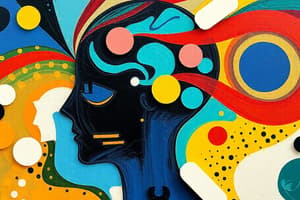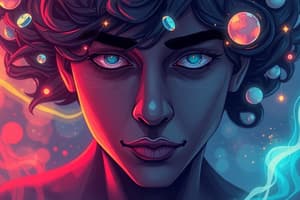Podcast
Questions and Answers
What are the symptoms of depression?
What are the symptoms of depression?
- Enthusiasm and rapid thought and speech patterns
- Intense feelings of sadness, hopelessness, and despair
- Changes in sleep patterns and appetite, loss of energy, and suicidal thoughts
- All of the above (correct)
What is mania characterized by?
What is mania characterized by?
- Loss of pleasure in usual activities
- Changes in sleep patterns and appetite, loss of energy
- Intense feelings of sadness, hopelessness, and despair
- Enthusiasm, rapid thought and speech patterns (correct)
What is the mechanism of action of most clinically useful antidepressant drugs?
What is the mechanism of action of most clinically useful antidepressant drugs?
- They decrease the production of norepinephrine in the brain
- They potentiate the actions of norepinephrine and/or serotonin in the brain (correct)
- They increase the production of serotonin in the brain
- They decrease the production of monoamines in the brain
Which of the following is NOT a type of antidepressant?
Which of the following is NOT a type of antidepressant?
What is the biogenic amine theory?
What is the biogenic amine theory?
What happens to presynaptic inhibitory receptor densities in the brain with antidepressant drug use?
What happens to presynaptic inhibitory receptor densities in the brain with antidepressant drug use?
What is the name of the antidepressant drug that is also known as ZYBAN?
What is the name of the antidepressant drug that is also known as ZYBAN?
What is the name of the antidepressant drug that is also known as CELEXA?
What is the name of the antidepressant drug that is also known as CELEXA?
What is the potential adverse effect of SSRIs when used in the presence of a MAOI or other highly serotonergic drug?
What is the potential adverse effect of SSRIs when used in the presence of a MAOI or other highly serotonergic drug?
What is a possible treatment option for men with erectile dysfunction and depression?
What is a possible treatment option for men with erectile dysfunction and depression?
What is a symptom of SSRI discontinuation syndrome?
What is a symptom of SSRI discontinuation syndrome?
Which of the following SSRIs has the lowest risk of causing a discontinuation syndrome?
Which of the following SSRIs has the lowest risk of causing a discontinuation syndrome?
What is a possible adverse effect of SSRIs?
What is a possible adverse effect of SSRIs?
What is an option for managing SSRI-induced sexual dysfunction?
What is an option for managing SSRI-induced sexual dysfunction?
What is a symptom of serotonin syndrome?
What is a symptom of serotonin syndrome?
What type of disorder is bulimia nervosa?
What type of disorder is bulimia nervosa?
What is the primary mechanism of action of SNRIs in treating depression?
What is the primary mechanism of action of SNRIs in treating depression?
Which of the following is NOT a potential use of SNRIs?
Which of the following is NOT a potential use of SNRIs?
What is the primary action of bupropion in alleviating depression?
What is the primary action of bupropion in alleviating depression?
What is a potential side effect of bupropion?
What is a potential side effect of bupropion?
Why is bupropion considered to have a relatively low risk for drug-drug interactions?
Why is bupropion considered to have a relatively low risk for drug-drug interactions?
What is a contraindication for the use of bupropion?
What is a contraindication for the use of bupropion?
What is the primary advantage of atypical antidepressants over TCAs and SSRIs?
What is the primary advantage of atypical antidepressants over TCAs and SSRIs?
What is a unique feature of bupropion compared to other antidepressants?
What is a unique feature of bupropion compared to other antidepressants?
What is the primary mechanism by which mirtazapine enhances neurotransmission?
What is the primary mechanism by which mirtazapine enhances neurotransmission?
What is a common side effect of mirtazapine?
What is a common side effect of mirtazapine?
Which of the following is a characteristic of tricyclic antidepressants (TCAs)?
Which of the following is a characteristic of tricyclic antidepressants (TCAs)?
What is the therapeutic effect of TCAs on mood?
What is the therapeutic effect of TCAs on mood?
Which of the following TCAs is a selective inhibitor of norepinephrine reuptake?
Which of the following TCAs is a selective inhibitor of norepinephrine reuptake?
What is a common timeframe for the onset of mood elevation with TCAs?
What is a common timeframe for the onset of mood elevation with TCAs?
Which of the following receptors does amoxapine block?
Which of the following receptors does amoxapine block?
What is a characteristic of mirtazapine compared to TCAs?
What is a characteristic of mirtazapine compared to TCAs?
What is the effect of Monoamine Oxidase Inhibitors (MAOIs) on neurotransmitter molecules?
What is the effect of Monoamine Oxidase Inhibitors (MAOIs) on neurotransmitter molecules?
Which MAOI is available in a transdermal delivery system?
Which MAOI is available in a transdermal delivery system?
What is the result of MAOIs forming stable complexes with the enzyme?
What is the result of MAOIs forming stable complexes with the enzyme?
What is a consequence of MAOIs inhibiting MAO in the liver and gut?
What is a consequence of MAOIs inhibiting MAO in the liver and gut?
Which patients may benefit from the stimulant properties of MAOIs?
Which patients may benefit from the stimulant properties of MAOIs?
What is a therapeutic use of MAOIs?
What is a therapeutic use of MAOIs?
What is a characteristic of most MAOIs?
What is a characteristic of most MAOIs?
Why is the use of MAOIs now limited?
Why is the use of MAOIs now limited?
Flashcards are hidden until you start studying
Study Notes
Antidepressants: Treatment of Depression and Mania
- Symptoms of depression: intense feelings of sadness, hopelessness, despair, and inability to experience pleasure in usual activities, changes in sleep patterns and appetite, loss of energy, and suicidal thoughts.
- Mania is characterized by the opposite behavior: enthusiasm, rapid thought and speech patterns.
Types of Antidepressants
- Selective Serotonin Reuptake Inhibitors (SSRIs)
- Examples: Citalopram, Escitalopram, Fluoxetine, Fluvoxamine, Paroxetine, Sertraline
- Serotonin/Norepinephrine Reuptake Inhibitors (SNRIs)
- Examples: Desvenlafaxine, Duloxetine, Venlafaxine
- Atypical Antidepressants
- Examples: Bupropion, Mirtazapine, Nefazodone, Trazodone
- Tricyclic Antidepressants (TCAs)
- Examples: Amitriptyline, Amoxapine, Clomipramine, Desipramine, Doxepin, Imipramine, Maprotiline, Nortriptyline, Protriptyline, Trimipramine
- Monoamine Oxidase Inhibitors (MAOIs)
- Examples: Isocarboxazid, Phenelzine, Selegiline, Tranylcypromine
Mechanism of Antidepressant Drugs
- Most clinically useful antidepressant drugs potentiate the actions of norepinephrine and/or serotonin in the brain.
- The biogenic amine theory proposes that depression is due to a deficiency of monoamines, such as norepinephrine and serotonin, at certain key sites in the brain.
- Mania is caused by an overproduction of these neurotransmitters.
Adverse Effects
- Headache, sweating, anxiety, and agitation
- Gastrointestinal effects (nausea, vomiting, diarrhea)
- Weakness and fatigue
- Sexual dysfunction
- Changes in weight
- Sleep disturbances (insomnia and somnolence)
- Potential for drug-drug interactions
Sexual Dysfunction
- Loss of libido, delayed ejaculation, and anorgasmia
- One option for managing SSRI-induced sexual dysfunction is to replace with an antidepressant having fewer sexual side effects, e.g., bupropion or mirtazapine.
Discontinuation Syndrome
- After abrupt withdrawal, agents with shorter half-lives and having inactive metabolites have a higher risk for adverse reaction.
- Fluoxetine has the lowest risk of causing an SSRI discontinuation syndrome.
- Signs of discontinuation syndrome include headache, malaise, and flu-like symptoms, agitation, and irritability.
Serotonin/Norepinephrine Reuptake Inhibitors (SNRIs)
- Inhibit the reuptake of both serotonin and norepinephrine.
- May be effective in treating depression in patients in whom SSRIs are ineffective.
- Depression is often accompanied by chronic painful symptoms, such as backache, muscle aches, postherpetic neuralgia, and fibromyalgia, against which SSRIs are also relatively ineffective.
Atypical Antidepressants
- The atypical antidepressants have actions at several different sites.
- They are not more efficacious than the TCAs or SSRIs, but their side effect profiles are different.
Bupropion
- Acts as a weak dopamine and norepinephrine reuptake inhibitor to alleviate the symptoms of depression.
- Its short half-life may require more than once-a-day dosing or the administration of an extended-release formulation.
- Also assists in decreasing the craving and attenuating the withdrawal symptoms for nicotine in tobacco users trying to quit smoking.
Mirtazapine
- Enhances serotonin and norepinephrine neurotransmission via mechanisms related to its ability to block presynaptic α2 receptors and block 5-HT2 receptors.
- It is a sedative because of its potent antihistaminic activity.
- Causes increased appetite and weight gain.
- It is markedly sedating, which may be an advantage in depressed patients having difficulty sleeping.
Tricyclic Antidepressants (TCAs)
- Block norepinephrine and serotonin reuptake into the neuron.
- Differ in adverse effects relative to the newer class of antidepressants.
- Include the tertiary amines, such as imipramine, amitriptyline, clomipramine, doxepin, and trimipramine.
- Include the secondary amines, such as desipramine and nortriptyline.
- Include the tetracyclics, such as protriptyline, maprotiline, and amoxapine.
Mechanism of Action of TCAs
- Inhibit the reuptake of norepinephrine and serotonin into the neuron.
- Block serotonergic, α-adrenergic, histaminic, and muscarinic receptors leading to adverse effects.
Monoamine Oxidase Inhibitors (MAOIs)
- May irreversibly or reversibly inactivate the enzyme, permitting neurotransmitter molecules to escape degradation and accumulate within the presynaptic neuron and leak into the synaptic space.
- Cause activation of norepinephrine and serotonin receptors, and may be responsible for their indirect antidepressant action.
Mechanism of Action of MAOIs
- Inhibit both MAO in the brain and MAO in the liver and gut that catalyze oxidative deamination of drugs and potentially toxic substances.
- Show a high incidence of drug-drug and drug-food interactions.
- Selegiline administered as the transdermal patch may produce less inhibition of gut and hepatic MAO at low doses because it avoids first-pass metabolism.
Studying That Suits You
Use AI to generate personalized quizzes and flashcards to suit your learning preferences.



